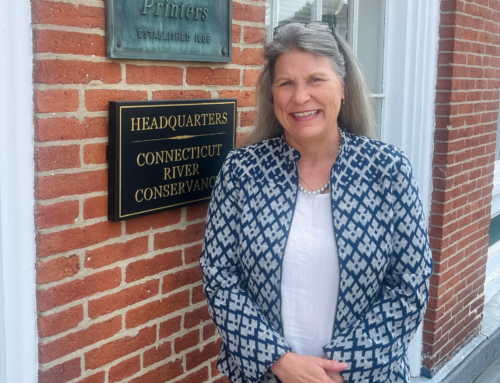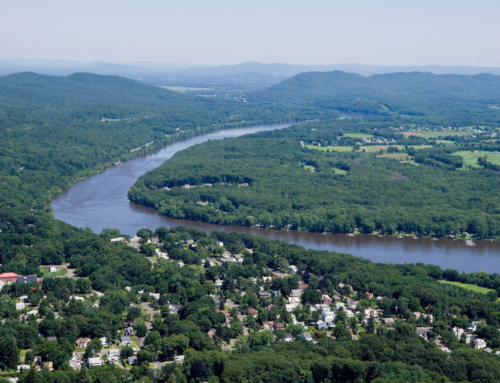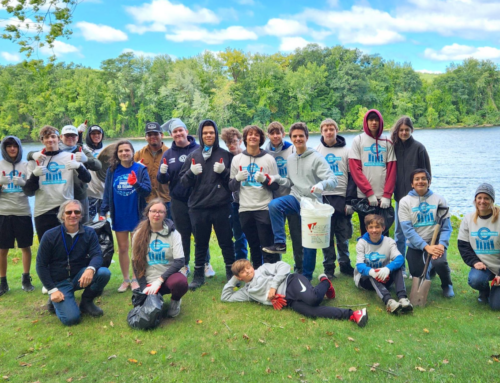Hall Building Renovation
Early Catalyst for Greenfield Revitalization
Greenfield, MA. – June 6, 2011 – Ten years ago the Town of Greenfield launched a major drive to revitalize its declining downtown and the Connecticut River Watershed Council (CRC) moved its headquarters and staff from a rented property in Easthampton and into 15 Bank Row, a building it purchased in downtown Greenfield. It was a daring move for the nonprofit organization.
“My father used to work in that building for E.A. Hall Printing back in the 1960’s,” said Greenfield Mayor William F. Martin. “In those days it was a very busy street. But ten years ago, when the Watershed Council came in as the cornerstone on Bank Row, the rest of the block was practically empty. Today in Greenfield we have almost a million dollars invested in buildings under construction.”
As CRC celebrates the 10th anniversary of its move to Greenfield, the town’s revitalization effort is now attracting the attention of people and businesses across the region. Construction of the Franklin Regional Transit Center, just down Bank Row, is one of many revitalization projects that have been carried out in the immediate neighborhood in the past decade.
“Our role as pioneers on Bank Row is completely consistent with our role as a catalyst for positive change,” said Andrew Fisk, newly-appointed CRC Executive Director. “Pictures from back then show that ours was the only occupied building on this side of the street. Now you can stand on our front porch and see at least five major downtown buildings that have been completely renovated since we decided to invest in Greenfield.”
The three-story, brick Greek Revival-style E.A. Hall Building was built in 1813 as the first Franklin County Courthouse and is listed on the National Register of Historic Places. In the September 22, 1999 edition of The Greenfield Recorder, historian Paul Jenkins wrote that “it is the most historical building still standing” (in Greenfield). The CRC’s renovation to the building preserved its historic character, restored its front façade, and developed the upper floors with the addition of an elevator.
In 2010, CRC constructed a water quality testing laboratory in the Hall Building. There it analyzes water samples collected from area rivers and streams by its own staff and volunteers and by those of other organizations, spanning an area from Holyoke to southeastern Vermont. Tenants in the building include The Literacy Project and ABR Inc. Environmental Research & Services.
“For nearly 60 years, CRC has been committed to protecting the entire Connecticut River watershed,” said Fisk. “Our investment in downtown Greenfield is a reflection of our commitment to our mission and to the many communities we work with up and down the river. It’s wonderful to be a part of Greenfield’s rebirth.”
The Connecticut River Watershed Council works to improve water quality and native fisheries in the Connecticut River’s 11,000-square mile watershed in the four states of Massachusetts, Connecticut, New Hampshire and Vermont. Through its web site and publications – such as the popular Connecticut River Boating Guide – it promotes conservation, recreation, and a sensible balance between the needs of human and natural communities.
The CRC delivers its services primarily through three River Stewards, based in Greenfield, Westminster VT, and Middletown CT. Most of the organization’s 11 employees work in the Greenfield office.
The CRC’s signature event is its annual Source to Sea Cleanup held every year in October. Coordinating thousands of volunteers, CRC has overseen the removal of hundreds of tons of trash and garbage from the Connecticut and its tributaries. The 15th Annual Cleanup will be held on Saturday, October 1st.
For information about CRC, the Cleanup, and the Connecticut River, go to ctriver.org
* * *
Press contact: Richard Ewald, CRC Planning & Development Director, rewald@ctriver.org
413-772-2020, X206







